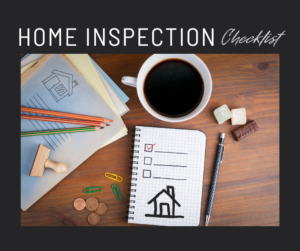 No house is perfect. Not even the brand-new ones. To avoid selecting a property with issues, looking for big-ticket items when previewing properties with your agent is important to make the investment worth it.
No house is perfect. Not even the brand-new ones. To avoid selecting a property with issues, looking for big-ticket items when previewing properties with your agent is important to make the investment worth it.
A home inspection checklist is a valuable tool to help look at and document certain home features when previewing. Note that a home inspection checklist should not be mistaken as a report, nor should it substitute for a professional home inspection. Rather, it is a way to document features and issues of the homes you are considering to help you compare them at the end of the day.
Here’s an example of items that should be included in a home inspection checklist that you can take when previewing homes:
THE BIG PICTURE
Take the time to check out the homes in the neighborhood that were constructed around the same time as the home you’re previewing. This will give you a general idea of the condition of your house. Pay attention to big-ticket items like the roof, siding, and foundation. The severity of major issues that can be seen are items that can be deal-breakers.
ROOF
A simple visual evaluation of the roof should be good but pay attention to the following:
- Check for any noticeable damage, such as broken tiles or missing shingles.
- Check for noticeable or obvious roof patches/repairs.
- Are you able to observe the chimney and flash? Can you tell if there are missing and damaged bricks or siding, or do you notice cracked joints?
- Check the gutters and downspouts. Are they attached securely to the home? Are they damaged in any way? Are there any signs of bending or sagging?
- Check for noticeable wood rot or other roof penetrations.
SIDING
There is a lot of siding on a home, and we recommend taking a pen and pad of paper with you to log any damage you may see as well at its location.
Depending on the type of siding, you could be looking for wood rot, nail pops, cracks, open joints, bricks falling away from the side, peeling paint, loose boards, or panels. Anything that doesn’t look correct needs to be noted.
FOUNDATION
- Does the foundation appear to be in good condition? Are there damaged bricks or masonry or cracks in the concrete or blocks? Do you notice any flaking components?
- Check for noticeable foundation and supporting wall issues. Is there evidence of bowing, bulging, or other irregularities?
- Are there signs or indications of damage from insect or termite infestation or rot for wooden components?
- Are there large trees growing near the property’s foundation?
FLOORS
- What flooring materials are used? Carpet, hardwood, tile, or stone?
- Are there stains or signs of damage?
- Will the floor need to be repaired, restored, or replaced?
WALLS
- Check the interior and exterior walls. Are they bowed, sagged, bulging, or leaning?
- Are there cracks? Note that gaps in the wall may be caused by several factors, from shoddy construction to inevitable movement over time.
- Is there any flaking or mismatched paint?
- What is the condition of the wall covering?
- For brick walls, check for any loose brick or cracks in mortar or spaces.
CEILINGS
- Are the ceilings smooth and intact?
- Are there stains or signs of previous water damage?
- Will any of the ceilings need repainting or repair?
- Note any significant cracks.
 WINDOWS and DOORS
WINDOWS and DOORS
- Check out the condition of the windows and doors. Do they operate and latch?
- Do the window and door frames appear square?
- Are the frame joints caulked and well-painted? Is there any chipping paint?
- Are there any cracks, rot, or decay?
- Do the locks work?
- Do the windows and doors have weather stripping? Are they in good condition?
KITCHEN AND BATHROOMS
- Are the plumbing fixtures or faucets loose?
- Are there cracks on the fixtures? Is there any broken-down caulking?
- Is there adequate water flow and water pressure at all fixtures?
- Do the sinks, tubs, and showers drain properly?
- Note the condition of the tubs and shower tiles.
- Are the commodes loose on the floor?
- Note any leakage, rust, unusual noises when running the water or draining, or any other signs of neglect.
ELECTRICAL
When testing electrical elements, make sure that all necessary safety measures are taken.
- Are there indications of exposed wiring?
- Are cables secured and protected?
- Can you tell if the fuses or breakers are overheating?
- Test electrical receptacles and switches for functionality.
- When was the last time the (HVAC) system – heating and cooling were inspected or serviced?
- Have upgrades been done?
- No home is complete without appliances. Check that all devices are working properly.
HVAC SYSTEM
Inspect and determine if the system has been serviced lately. Look for upkeep by the owner.
- Is there a speck of dust or dirt around the system? Are air vents dusty/dirty?
WATER HEATER
The water heater is one of the most important appliances in your home and is often taken for granted.
- When looking at the water heater, is there evidence of rust or any leaking at the top or the bottom of the water heater?
- Are there any cracks?
- Does it make noises?
- Do you notice smelly or discolored water?
For many good reasons, a home inspection checklist can be a valuable tool to help you preview properties more systematically so you know what features and issues went with which home. This information may later help you decide which home to choose to make an offer on, likely preventing a lot of stress.
Click here to download and print our Knoxville Home Inspection Checklist. Print and take one to each home you preview so you can jot down the things you find during the home visit. This way, you can track and know which home has what features and/or issues.
If you or someone you know is looking for a home inspector in Knoxville TN and surrounding cities, please be sure to consider Accu-Spec Inspection Services, PC. In addition, you can call 865-658-1050 or visit our website for more information.




